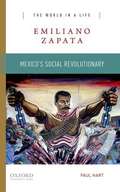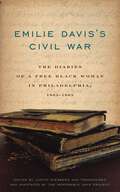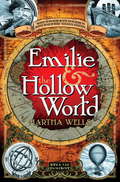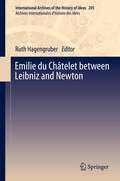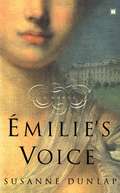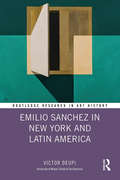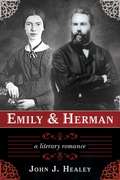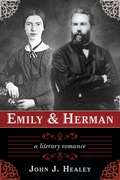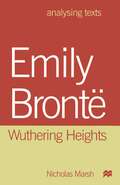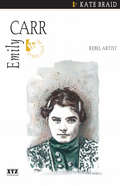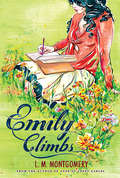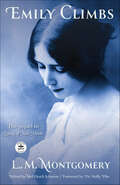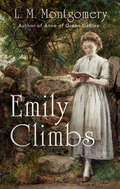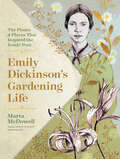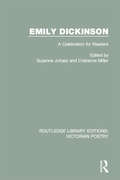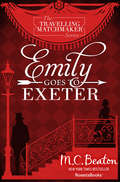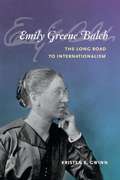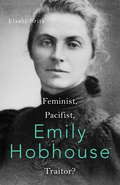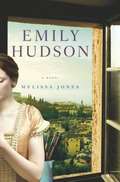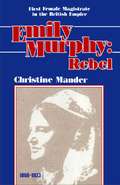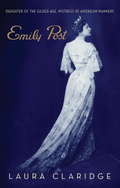- Table View
- List View
Emiliano Zapata: Mexico's Social Revolutionary (THE WORLD IN A LIFE)
by Paul HartZapata continues to wield great influence throughout the region today. His advocacy of agrarian reform and peasants' rights, his dashing lifestyle, and his assassination make him a fascinating figure.
Emilie Davis’s Civil War: The Diaries of a Free Black Woman in Philadelphia, 1863–1865
by Judith Giesberg The Memorable Days ProjectEmilie Davis was a free African American woman who lived in Philadelphia during the Civil War. She worked as a seamstress, attended the Institute for Colored Youth, and was an active member of her community. She lived an average life in her day, but what sets her apart is that she kept a diary. Her daily entries from 1863 to 1865 touch on the momentous and the mundane: she discusses her own and her community’s reactions to events of the war, such as the Battle of Gettysburg, the Emancipation Proclamation, and the assassination of President Lincoln, as well as the minutiae of social life in Philadelphia’s black community. Her diaries allow the reader to experience the Civil War in “real time” and are a counterpoint to more widely known diaries of the period. Judith Giesberg has written an accessible introduction, situating Davis and her diaries within the historical, cultural, and political context of wartime Philadelphia. In addition to furnishing a new window through which to view the war’s major events, Davis’s diaries give us a rare look at how the war was experienced as a part of everyday life—how its dramatic turns and lulls and its pervasive, agonizing uncertainty affected a northern city with a vibrant black community.
Emilie Davis’s Civil War: The Diaries of a Free Black Woman in Philadelphia, 1863–1865
by The Memorable Days ProjectEmilie Davis was a free African American woman who lived in Philadelphia during the Civil War. She worked as a seamstress, attended the Institute for Colored Youth, and was an active member of her community. She lived an average life in her day, but what sets her apart is that she kept a diary. Her daily entries from 1863 to 1865 touch on the momentous and the mundane: she discusses her own and her community’s reactions to events of the war, such as the Battle of Gettysburg, the Emancipation Proclamation, and the assassination of President Lincoln, as well as the minutiae of social life in Philadelphia’s black community. Her diaries allow the reader to experience the Civil War in “real time” and are a counterpoint to more widely known diaries of the period. Judith Giesberg has written an accessible introduction, situating Davis and her diaries within the historical, cultural, and political context of wartime Philadelphia. In addition to furnishing a new window through which to view the war’s major events, Davis’s diaries give us a rare look at how the war was experienced as a part of everyday life—how its dramatic turns and lulls and its pervasive, agonizing uncertainty affected a northern city with a vibrant black community.
Emilie and the Hollow World
by Martha WellsWhile running away from home for reasons that are eminently defensible, Emilie's plans to stow away on the steamship Merry Bell and reach her cousin in the big city go awry, landing her on the wrong ship and at the beginning of a fantastic adventure.Taken under the protection of Lady Marlende, Emilie learns that the crew hopes to use the aether currents and an experimental engine, and with the assistance of Lord Engal, journey to the interior of the planet in search of Marlende's missing father.With the ship damaged on arrival, they attempt to traverse the strange lands on their quest. But when evidence points to sabotage and they encounter the treacherous Lord Ivers, along with the strange race of the sea-lands, Emilie has to make some challenging decisions and take daring action if they are ever to reach the surface world again.
Emilie and the Hollow World
by Martha WellsWhile running away from home for reasons that are eminently defensible, Emilie's plans to stow away on the steamship Merry Bell and reach her cousin in the big city go awry, landing her on the wrong ship and at the beginning of a fantastic adventure.Taken under the protection of Lady Marlende, Emilie learns that the crew hopes to use the aether currents and an experimental engine, and with the assistance of Lord Engal, journey to the interior of the planet in search of Marlende's missing father.With the ship damaged on arrival, they attempt to traverse the strange lands on their quest. But when evidence points to sabotage and they encounter the treacherous Lord Ivers, along with the strange race of the sea-lands, Emilie has to make some challenging decisions and take daring action if they are ever to reach the surface world again.
Emilie du Châtelet between Leibniz and Newton
by Ruth HagengruberEmilie du Châtelet was one of the most influential woman philosophers of the Enlightenment. Her writings on natural philosophy, physics, and mechanics had a decisive impact on important scientific debates of the 18th century. Particularly, she took an innovative and outstanding position in the controversy between Newton and Leibniz, one of the fundamental scientific discourses of that time. The contributions in this volume focus on this "Leibnitian turn". They analyze the nature and motivation of Emilie du Châtelet's synthesis of Newtonian and Leibnitian philosophy. Apart from the Institutions Physiques they deal with Emilie du Châtelet's annotated translation of Isaac Newton's Principia. The chapters presented here collectively demonstrate that her work was an essential contribution to the mediation between empiricist and rationalist positions in the history of science.
Emilie's Voice
by Susanne DunlapSet against the backdrop of Paris and the court of Versailles, émilie's Voice introduces a young heroine of modest upbringing who possesses a special gift: the voice of an angel. When distinguished composer Marc-Antoine Charpentier hears émilie's voice, he offers to instruct her in the art of singing with the ultimate goal of presenting her at the court of Louis XIV. Her head filled with dreams of elegant gowns, opulent jewels, and the thrill of someday performing in the great houses of Paris, she begins her training -- until a scheming noblewoman looking to unseat the king's official mistress interferes by preemptively bringing émilie to Versailles. There, amid royal pomp and splendor, she is swept up in dangerous palatial intrigues, becoming a pawn in aristocratic power games. But it is the passionate battle for control over her life and career waged between Charpentier and Louis XIV's official court composer, Jean-Baptiste Lully, that has far-reaching consequences for a girl on the verge of becoming a woman and a singer on the verge of becoming extraordinary.
Emilio Sanchez in New York and Latin America (Routledge Research in Art History)
by Victor DeupiThis book focuses on the life and artistic activities of Emilio Sanchez (1921–1999) in New York, and Latin America in the 1940s and 1950s. More specifically, the book will consider Sanchez in the wider context of mid-century Cuban artists, and cross-cultural exchange between New York, Cuba, and the Caribbean. The book reflects on why Sanchez chose to be a mobile observer of the American and Caribbean vernacular at a time when such an approach seemed at odds with the mainstream avant-garde. The book includes a foreword by Dr. Ann Koll, former Executive Director/Curator of the Emilio Sanchez Foundation, and an introduction by Dr. Nathan J. Timpano, University of Miami Department of Art and Art History. This book will be of interest to scholars in modern art, Caribbean studies, architectural history, and Latin American and Hispanic studies.
Emily & Herman
by John J. HealeyThe manuscript of this novel was discovered by John J. Healey in a box left by his grandfather, Professor Vincent P. Healey, after his death. This engaging work of fiction is a romantic account in which four iconic figures of American Letters play a leading role. In the summer of 1851 Herman Melville was finishing Moby Dick on his family farm in the Berkshire Hills of western Massachusetts. Surrounded by his mother, sisters and pregnant wife, it was a calm and productive season until his neighbor Nathaniel Hawthorne lured him to Amherst. There they met twenty-year-old Emily Dickinson and her brother Austin. On a whim the two distinguished authors invited the Dickinson siblings to accompany them on a trip to Boston and New York. In Manhattan they met journalist Walt Whitman and William Johnson, a runaway slave, and it was there, despite their efforts to control it, that Emily and Herman fell in love. This, for the first time, is their story.
Emily & Herman: A Literary Romance
by John J. Healey“A genuinely insightful” historical novel uniting literary lions Emily Dickinson and Herman Melville in intrigue and forbidden romance (Booklist). It’s the summer of 1851. Herman Melville is finishing Moby Dick on his family farm in the Berkshire Hills of western Massachusetts, surrounded by his mother, sisters, and pregnant wife. It’s a calm and productive season until Herman’s neighbor, Nathaniel Hawthorne, lures him to Amherst. There they meet chaste, twenty-year-old Emily Dickinson and her brother, Austin. On a whim, the two distinguished authors invite the Dickinson siblings to accompany them on a trip to Boston and New York. It’s here that they cross paths with journalist Walt Whitman and runaway slave, William Johnson. And it’s here that Emily and Herman—bold maiden and married man—both flushed with the excitement of new adventures, fall uncontrollably in love. Beautifully capturing the heady longings of puritan life, moral quandaries, philosophical quests, and social change of mid-nineteenth century America, Emily & Herman is a love story for all time.
Emily Bronte: Wuthering Heights (Analysing Texts)
by Nicholas MarshChapters on the narrative frame, characters, imagery and symbols, structure and themes use practical analysis to build and refine our insight into Wuthering Heights. Part Two gives information about Emily Brontë's life and works, a discussion of this novel's place in the development of fiction and a comparison of three important critical views. Suggestions for further reading, fully explained examples of analysis and suggestions for further work make this volume both accessible and a bridge to further study.
Emily Carr
by Kate BraidAs a child she was "contrary,"as a young woman she defied convention to choose art over marriage, and as a middle-aged woman she was considered a full-blown eccentric. Listening to her own inner voice, Emily Carr created an art unique to British Columbia.
Emily Climbs
by L. M. Montgomery"I love Emily."--Madeleine L'Engle Keeping a Promise Was Never So Difficult Emily Starr knows that she is destined to become a great writer. But she also knows that her life will be absolutely miserable if she can't attend school with her bosom friends. And the only way her strict Aunt Elizabeth will let her go to high school in Shrewsbury is if Emily surrenders her pen--for good. Emily almost convinces herself that she can survive without writing, especially when she catches the eye of Teddy Kent. But she can't stop herself from secretly recording all of her hilarious adventures and coming-of-age heartbreaks. When the local paper gets ahold of her writing and offers her an exciting opportunity, Emily will have to decide how much she's willing to sacrifice as she climbs towards her dreams. This new edition lovingly restores the original, unabridged text and includes an all-new, exclusive introduction with special memories from L.M. Montgomery's granddaughter. What Readers Are Saying: "A spunky, mysterious, and lightly romantic read." "There is much more to this book than anyone would expect--wonderful, complex characters and very subtle, sly underlying themes." "Five stars for being beautiful, inspiring, funny, and magical."
Emily Climbs
by L. M. MontgomeryThe Sequel to the Classic Emily of New Moon Emily Byrd Starr must write—burns to write. She writes out her problems and pours out her dreams, spins stories and poems from flashes of insight. Writing sustained her through the loss of her father and sustains her now despite family disapproval. Though she’s found a home at New Moon Farm with her aunts and cousin, and dear friends in quiet Blair Water, she knows she needs more if she’s ever going to make her mark on the world. She dreads the coming years, left behind when her friends go away to school. Then Aunt Elizabeth offers her a chance to go with them—and demands an unbearable sacrifice. Can she give up her writing—or her beloved home—to further her ambition? Follow along with Emily, in her own words, as she grows from girl to young woman, balancing tradition and discovery. In this fine new edition, with new foreword by Canadian scholar Dr. E. Holly Pike, find out why Emily Climbs, like author L.M. Montgomery’s most famous series about Anne of Green Gables, has never gone out of print
Emily Climbs: A Virago Modern Classic (The Emily Trilogy #2)
by L. M. MontgomerySecond in the trilogy about an orphan girl with big dreams from the beloved author of Anne of Green Gables and featured in Netflix&’s Russian Doll.Orphaned and sent to live with her stern aunts at New Moon Farm on Prince Edward Island, Emily Byrd Starr lives a solitary life. She finds comfort in language and writing. She loves to read the dictionary and frequently records all of her problems and worries in her journal—much more fun than knitting stockings.Fortunately, Emily has made some friends but they&’re heading off to high school in Shrewsbury. Emily&’s aunt Elizabeth allows her to go on the condition that she stop writing. With the help of her cousin, Emily manages to strike a deal.Once in Shrewsbury, Emily embarks on her climb toward success with her friends—Ilse, Teddy, and Perry—by her side. Everything begins to go so well. Emily starts writing stories and poems—she even writes for the town newspaper. Soon sparks begin to fly between her and Teddy. But when a fantastic opportunity come her way, Emily is forced to make a decision that will alter the course of her life forever . .
Emily Dickinson's Gardening Life: The Plants and Places That Inspired the Iconic Poet
by Marta McDowell“A visual treat as well as a literary one, Emily Dickinson’s Gardening Life will be deeply satisfying for gardeners and garden lovers, connoisseurs of botanical illustration, and those who seek a deeper understanding of the life and work of Emily Dickinson.” —The Wall Street Journal Emily Dickinson was a keen observer of the natural world, but less well known is the fact that she was also an avid gardener—sending fresh bouquets to friends, including pressed flowers in her letters, and studying botany at Amherst Academy and Mount Holyoke. At her family home, she tended both a small glass conservatory and a flower garden. In Emily Dickinson’s Gardening Life, award-winning author Marta McDowell explores Dickinson’s deep passion for plants and how it inspired and informed her writing. Tracing a year in the garden, the book reveals details few know about Dickinson and adds to our collective understanding of who she was as a person. By weaving together Dickinson’s poems, excerpts from letters, contemporary and historical photography, and botanical art, McDowell offers an enchanting new perspective on one of America’s most celebrated but enigmatic literary figures.
Emily Dickinson: A Celebration for Readers (Routledge Library Editions: Victorian Poetry #3)
by Suzanne Juhasz Cristanne MillerThe focus of this title, first published in 1989, begins with Dickinson’s poems themselves and the ways in which we read them. There are three readings for each of the six poems under consideration that are both complementary and provocative. The selected poems show Dickinson speaking of herself in increasingly wider relationships – to love, the outside world, death and eternity – and are grouped together to reveal her overlapping attitudes and feelings. Other topics discussed range from general epistemological and critical considerations to the poet’s self-identification and the process of reading her poetry as a feminist critic. This title will be of interest to students of literature.
Emily Goes to Exeter: A Novel Of Regency England - Being The First Volume Of The Traveling Matchmaker (The Travelling Matchmaker Series #1)
by M. C. BeatonThe New York Times–bestselling Traveling Matchmaker series begins with a Regency tale of seductive subterfuge—from the author of the Agatha Raisin novels. A dead employer&’s legacy of five thousand pounds allows spinster Hannah Pym to resign from housekeeping and find adventure travelling the English countryside by stagecoach. But adventure soon finds Miss Pym in the form of Miss Emily Freemantle, a spoiled, violet-eyed beauty fleeing an arranged marriage to a rake she has never met. When the girl&’s darkly handsome betrothed boards their stage, Miss Pym is certain Emily was rash to bolt from this aristocratic catch. And so as soon as the travellers repair to an inn, Miss Pym begins her matchmaking. Although Lord Ranger Harley complains he&’ll not marry an ungrateful minx, Miss Pym suspects once she&’s marshaled the couple into sharing intimate household chores, all romantic knots will be untangled! &“Hannah Pym is not above an amusing deviousness, which brings about the happy endings in this unstartling, light entertainment.&” —Publishers Weekly
Emily Greene Balch: The Long Road to Internationalism
by Kristen E. GwinnA well-known American academic and cofounder of Boston's first settlement house, Emily Greene Balch was an important Progressive Era reformer and advocate for world peace. Balch served as a professor of economics and sociology at Wellesley College for twenty years until her opposition to World War I resulted with the board of trustees to refusing to renew her contract. Afterwards, Balch continued to emphasize the importance of international institutions for preventing and reconciling conflicts. She was awarded a Nobel Peace Prize in 1946 for her efforts in cofounding and leading the Women's International League for Peace and Freedom (WILPF). In tracing Balch's work at Wellesley, for the WILPF, and for other peace movements, Kristen E. Gwinn draws on a rich collection of primary sources such as letters, lectures, a draft of Balch's autobiography, and proceedings of the WILPF and other organizations in which Balch held leadership roles. Gwinn illuminates Balch's ideas on negotiated peace, internationalism, global citizenship, and diversity while providing pointed insight into her multifaceted career, philosophy, and temperament. Detailing Balch's academic research on Slavic immigration and her arguments for greater cultural and monetary cohesion in Europe, Gwinn shows how Balch's scholarship and teaching reflected her philosophical development. This first scholarly biography of Balch helps contextualize her activism while taking into consideration changes in American attitudes toward war and female intellectuals in the early twentieth century.
Emily Hahn on China: Chiang Kai-Shek and China Only Yesterday, 1850–1950
by Emily HahnChinese history is brought to vivid life by the “quintessential New Yorker narrator” and author of The Soong Sisters, who lived in China from 1935 to 1941 (The New York Times). Chiang Kai-Shek: As the head of the Nationalist Party, Chiang led the Republic of China for over two decades from 1927 through the Japanese invasion, World War II, and the civil war that ended with a Communist victory in 1949. After defeat, he retreated with his government to Taiwan, where he continued to lead as president of the exiled Republic of China. Published in 1955, this in-depth biography by legendary New Yorker writer Emily Hahn examines Chiang’s childhood in southern China, his relationship with revolutionary Sun Yat-Sen, his rise to power, and his battles with the Japanese Imperial Army and Communist forces led by Mao Zedong, as well as chronicling his marriage to the glamorous, American-educated Soong May-ling (the youngest of the influential siblings portrayed in Hahn’s The Soong Sisters), who converted her husband to Christianity and helped him enact social reforms. Casting a critical eye on Sino-American relations, Hahn sheds new light on a complex leader, who was one of the most important global political figures of the last century. “[Hahn] writes . . . with an impassioned warmth . . . colorful reading . . . An irreparable past is echoed in the forlorn note sounded here.” —Kirkus Reviews China Only Yesterday, 1850–1950: With an insider’s knowledge of Chinese culture and politics, Hahn delivers a sharply observant book that illuminates a century of China’s tumultuous history. Her “absorbing” history begins with the Treaty of Nanking, which gave Western powers access to five of China’s eastern ports, and covers the British colonization of Hong Kong, the rise of the tea trade, the Opium Wars, the arrival of Christian missionaries, the Boxer Rebellion, the revolutionary movement led by Sun Yat-Sen, the overthrow of the Ch’ing Dynasty, the escalating tensions between the Communist and Nationalist parties, and the Japanese invasion on the eve of World War II—which Hahn experienced firsthand (Kirkus Reviews). The final chapters cover the civil war, which ended with Chairman Mao’s formation of the People’s Republic of China and Chiang Kai-shek’s retreat to Taiwan. “[An] observant, satisfying book.” —Kirkus Reviews
Emily Hobhouse: Feminist, Pacifist, Traitor?
by Elsabé BritsWinner of the Mbokodo Award for Women in the Arts for Literature, the ATKV (Afrikaans Language and Culture Association) Award for non-fiction and the kykNet/Rapport Award for non-fiction. 'Here was Emily . . . in these diaries and scrapbooks. An unprecedented, intimate angle on the real Emily'Elsabé Brits has drawn on a treasure trove of previously private sources, including Emily Hobhouse's diaries, scrap-books and numerous letters that she discovered in Canada, to write a revealing new biography of this remarkable Englishwoman. Hobhouse has been little celebrated in her own country, but she is still revered in South Africa, where she worked so courageously, selflessly and tirelessly to save lives and ameliorate the suffering of thousands of women and children interned in camps set up by British forces during the Anglo-Boer War, in which it is estimated that over 27,000 Boer women and children died; and where her ashes are enshrined in the National Women's Monument in Bloemfontein. During the First World War, Hobhouse was an ardent pacifist. She organised the writing, signing and publishing in January 1915 of the 'Open Christmas Letter' addressed 'To the Women of Germany and Austria'. In an attempt to initiate a peace process, she also secretly metwith the German foreign minister Gottlieb von Jagow in Berlin, for which some branded her a traitor. In the war's immediate aftermath she worked for the Save the Children Fund in Leipzig and Vienna, feeding daily for over a year thousands of children, who would otherwise have starved. She later started her own feeding scheme to alleviate ongoing famine.Despite having been instrumental in saving thousands of lives during two wars, Hobhouse died alone - spurned by her country, her friends and even some of her relatives. Brits brings Emily's inspirational and often astonishing story, spanning three continents, back into the light.
Emily Hudson
by Melissa JonesAt the start of the American Civil War, Emily, an orphan, is expelled from school because of her "extravagant" friendship with another pupil and her unsettlingly wild nature. Sent to live with her rich, puritanical uncle and his family by the sea in Newport, she longs to be an artist, but her attempts at selfexpression are frowned upon by her estranged family. Her uncle seeks to rid himself of her through a marriage, even though she has no fortune. Despite the formidable restraints of her new life, Emily forms a close alliance with her cousin William. Ailing and ambivalent about his sexuality, William becomes obsessed by Emily's spirit and beauty and uses it as a way of funding his own creativity. He rescues Emily from an uncertain future by inviting her to accompany him to England, where she enrolls as an art student, dependent on his support. Dramatically told in beautiful and tender prose, Emily Hudson is a brilliantly readable novel that will appeal to anybody who has ever sought to be true to themselves but also to find love.
Emily Murphy: Rebel
by Christine ManderIn this comprehensive biography, Christine Mander depicts the life and times of Emily Murphy with a refreshing candor and vitality. A true Canadian heroine – pioneering feminism, writer (under the alias Janey Canuck), patriot, mother, anti-drug crusader, first woman magistrate of the British Empire and rebel – Emily Murphy defied conventional labels. To Hell with Women Magistrates, fulminated one court official on her appointment. Her greatest triumph came in 1929 when Lord Chancellor Sankey reversed the Canadian Supreme Court decision by ruling that women are persons under the constitution and therefore eligible for any political office. When Emily Murphy died in 1933, after a long battle with diabetes, her friend and fellow activist Nellie McClung remarked, Mrs. Murphy loved a fight and so far as I know, never turned her back on one.
Emily Post
by Laura ClaridgeLaura Claridge has written the first biography of the high society woman who became an advocate for the middle class and immigrant Americans. Today, almost a half century after the writer's death, the name "Emily Post" remains a touchstone of twenty-first century Americans.
Emily Wilde's Compendium of Lost Tales: the enchanting and romantic magical academia phenomenon! (Emily Wilde Series #3)
by Heather Fawcett'A charmingly whimsical delight. . . Five dazzling, gladdening stars' India Holton, author of The Wisteria Society of Lady ScoundrelsThe third instalment in the enchanting light academia Emily Wilde books, about a curmudgeonly scholar of folklore and the fae prince she loves, from Sunday Times bestselling author Heather Fawcett.Emily Wilde has spent her life studying faeries. A renowned dryadologist, she has documented hundreds of species of Folk in her Encyclopaedia of Faeries. Now she is about to embark on her most dangerous academic project yet: studying the inner workings of a faerie realm-as its queen.Along with her former academic rival-now fiancé-the dashing and mercurial Wendell Bambleby, Emily is immediately thrust into the deadly intrigues of Faerie as the two of them seize the throne of Wendell's long-lost kingdom, which Emily finds a beautiful nightmare, filled with scholarly treasures.Emily has been obsessed with faerie stories her entire life, but at first she feels as ill-suited to Faerie as she did to the mortal world-how could an unassuming scholar like herself pass for a queen? Yet there is little time to settle in-Wendell's murderous stepmother has placed a deadly curse upon the land before vanishing without a trace. It will take all of Wendell's magic-and Emily's knowledge of stories-to unravel the mystery before they lose everything they hold dear.Praise for the Emily Wilde books:'Forget dark academia: give me instead this kind of winter-sunshined, sharp-tongued and footnoted academia, full of field trips and grumpy romance' Freya Marske, author of A Marvellous Light'A darkly gorgeous fantasy that sparkles with snow and magic, this book wholly enchanted me' Sangu Mandanna, author of The Very Secret Society of Irregular Witches'A thoroughly charming academic fairy tale, complete with footnotes and a low-key grumpy romance' Guardian'Enchanting in every sense of the word. . . This book is real magic' H. G. Parry, author of The Magician's Daughter'A book so vividly, endlessly enchanting, so crisply assured, so rich and complete and wise and far-reaching in its worldbuilding that you'll walk away half ensorcelled, sure Fawcett found Emily Wilde's journal in some sea-stained trunk' Melissa Albert'The ideal book to curl up with on a chilly winter's evening. . . this book is an absolute delight.' Megan Bannen, author of The Undertaking of Hart and Mercy'I enjoyed every word of this gorgeously written fairy tale featuring a grumpy heroine and an utterly charming love interest' Isabel Ibañez, author of Woven In Moonlight
